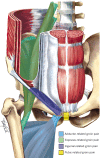Doha agreement meeting on terminology and definitions in groin pain in athletes
- PMID: 26031643
- PMCID: PMC4484366
- DOI: 10.1136/bjsports-2015-094869
Doha agreement meeting on terminology and definitions in groin pain in athletes
Abstract
Background: Heterogeneous taxonomy of groin injuries in athletes adds confusion to this complicated area.
Aim: The 'Doha agreement meeting on terminology and definitions in groin pain in athletes' was convened to attempt to resolve this problem. Our aim was to agree on a standard terminology, along with accompanying definitions.
Methods: A one-day agreement meeting was held on 4 November 2014. Twenty-four international experts from 14 different countries participated. Systematic reviews were performed to give an up-to-date synthesis of the current evidence on major topics concerning groin pain in athletes. All members participated in a Delphi questionnaire prior to the meeting.
Results: Unanimous agreement was reached on the following terminology. The classification system has three major subheadings of groin pain in athletes: 1. Defined clinical entities for groin pain: Adductor-related, iliopsoas-related, inguinal-related and pubic-related groin pain. 2. Hip-related groin pain. 3. Other causes of groin pain in athletes. The definitions are included in this paper.
Conclusions: The Doha agreement meeting on terminology and definitions in groin pain in athletes reached a consensus on a clinically based taxonomy using three major categories. These definitions and terminology are based on history and physical examination to categorise athletes, making it simple and suitable for both clinical practice and research.
Keywords: Consensus statement; Evidence-based; Groin; Hip; Injury.
Published by the BMJ Publishing Group Limited. For permission to use (where not already granted under a licence) please go to http://group.bmj.com/group/rights-licensing/permissions.
Figures

References
-
- Branci S, Thorborg K, Nielsen MB, et al. . Radiological findings in symphyseal and adductor-related groin pain in athletes: a critical review of the literature. Br J Sports Med 2013;47:611–19. - PubMed
Publication types
MeSH terms
LinkOut - more resources
Full Text Sources
Other Literature Sources
Medical
